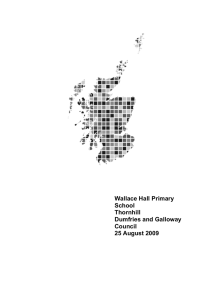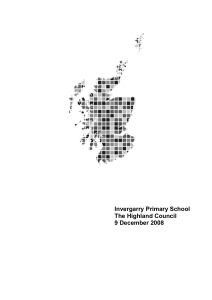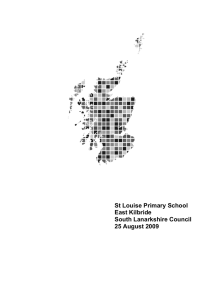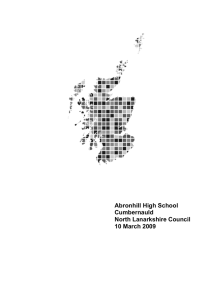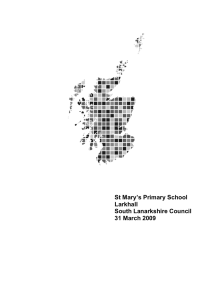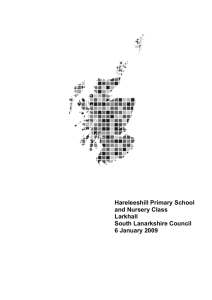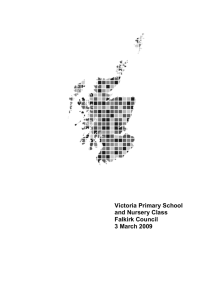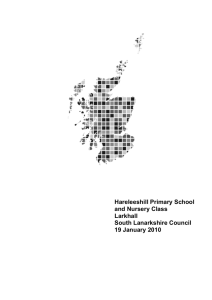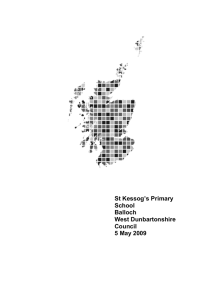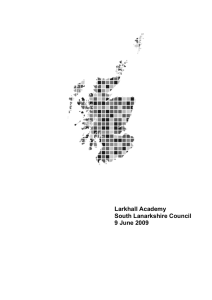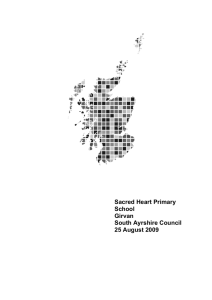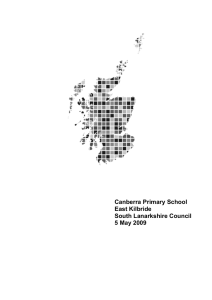Burrelton Primary School Perth and Kinross Council 30 June 2009
advertisement
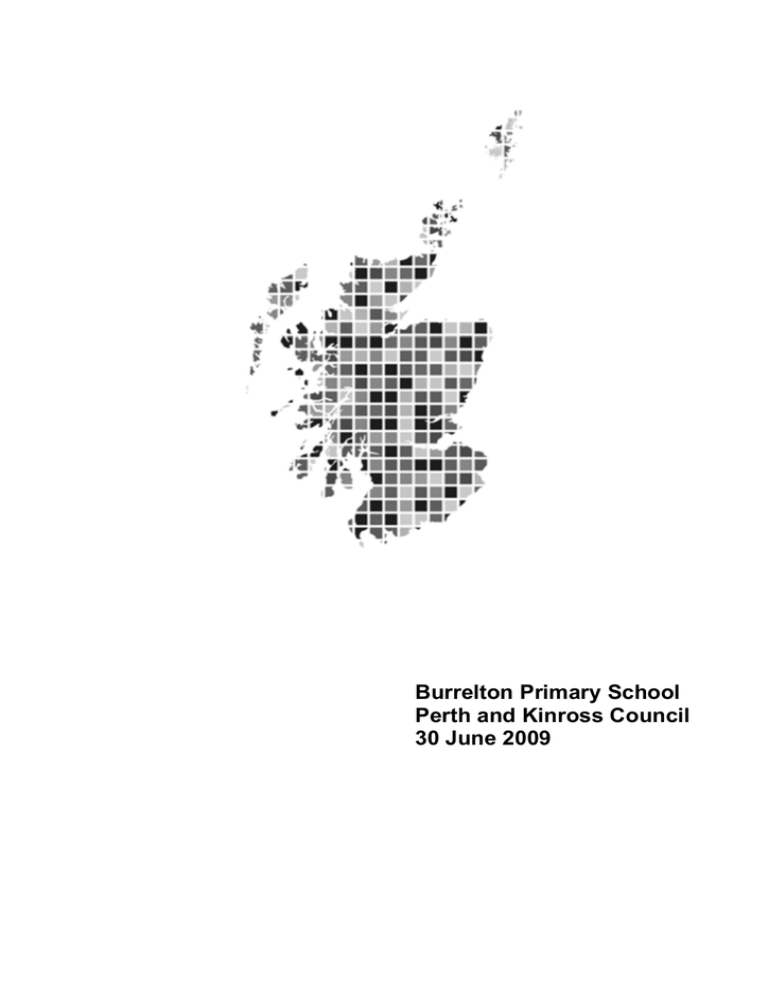
Burrelton Primary School Perth and Kinross Council 30 June 2009 This report tells you about the quality of education at the school1. We describe how children benefit from learning there. We explain how well they are doing and how good the school is at helping them to learn. Then we look at the ways in which the school does this. We describe how well the school works with other groups in the community, including parents2 and services which support children. We also comment on how well staff and children work together and how they go about improving the school. Our report describes the ‘ethos’ of the school. By ‘ethos’ we mean the relationships in the school, how well children are cared for and treated and how much is expected of them in all aspects of school life. Finally, we comment on the school’s aims. In particular, we focus on how well the aims help staff to deliver high quality learning, and the impact of leadership on the school’s success in achieving these aims. If you would like to learn more about our inspection of the school, please visit www.hmie.gov.uk. Here you can find analyses of questionnaire returns. Where applicable, you will also be able to find descriptions of good practice in the school. 1 2 The term ‘school’ is used to include the work of the nursery class, where relevant. Throughout this report, the term ‘parents’ should be taken to include foster carers, residential care staff and carers who are relatives or friends. Contents 1. The school 2. Particular strengths of the school 3. Examples of good practice 4. How well do children learn and achieve? 5. How well do staff work with others to support children’s learning? 6. Are staff and children actively involved in improving their school community? 7. Does the school have high expectations of all children? 8. Does the school have a clear sense of direction? 9. What happens next? 1. The school Burrelton Primary School is a non-denominational school. It serves the village of Burrelton and the surrounding rural area. The roll was 77 when the inspection was carried out in May 2009. Children’s attendance was above the national average in 2007/2008. 1 2. Particular strengths of the school • Children’s growing independence as learners and their skills in working with others. • High quality relationships between staff and children. • Well behaved and courteous children who are keen to learn. • The school’s success in promoting health and wellbeing across the school community. • The headteacher’s effective leadership of improvement, ably supported by the principal teachers. 3. Examples of good practice • Outdoor learning. • Children’s involvement in developing Curriculum for Excellence in their school. 2 4. How well do children learn and achieve? Learning and achievement Across the stages children respond very positively to extensive opportunities to accept responsibility. Older children can identify the skills they need in class to be confident, successful, responsible and effective learners. Others take responsibility for organising wall displays and ‘Thinking Together’ activities in their citizenship groups. Children are successful in their learning, for example during challenging tasks such as the World War II museum project and in their roles as ‘Golden House’ leaders and ‘Fairplay’ buddies. Children at P1/P2 and P4/P5 are developing good skills in art and design. At P3 they use a range of musical instruments well to interpret sounds within a song. In their Scottish week, they successfully recited poetry and almost all children at P6/P7 have had a poem published in a national competition. Children enjoy learning and are becoming increasingly confident and independent. They work well together in pairs and groups and settle quickly to tasks even when sometimes the tasks are too easy. Children are aware of how to improve their work. They feel safe, happy and cared for. They recognise that they are gaining leadership skills from taking part in sports, music, art classwork and out-of-school learning. Children are very aware of how to care for the environment and are very knowledgeable about recycling and saving energy. Their efforts have helped the school to win two Eco-Schools Scotland Green Flags. Children are successful in developing their knowledge and skills in aspects of science. As a result of children’s achievements in promoting healthy lifestyles, the school has gained an authority award as a Health Promoting School. In recent years, children, including those with additional support needs, have been making very good progress from their prior achievement. Almost all attain national standards of attainment in reading. Most attain these in writing and mathematics. An increasing number of children achieve these levels earlier than expected. In English language, children have well developed skills in listening and talking. They use these to good effect to express their points of view 3 and when delivering presentations at assemblies or to external audiences. Children read confidently and with understanding. Those at P1/P2 ably compare and discuss the content of their books. Most children write extended pieces for a range of purposes. In mathematics, almost all children are competent in written and oral calculations. They handle information well and apply their learning across other areas. For example, at P6/P7 they have used their knowledge of angles, ratio and measurement in their Forest School learning activities. Most children confidently identify appropriate ways to solve problems. Curriculum and meeting learning needs Staff provide a varied, stimulating curriculum which is relevant to children’s interests. Teachers are making very good use of guidance from Curriculum for Excellence to help them make learning both relevant and enjoyable. Across the school children are involved in choosing and planning their topic work. Staff recognise the need to make more use of technology to support children’s learning. Children are benefitting from two hours of good quality physical education each week. Staff are beginning to involve children in developing their skills in literacy, numeracy, enterprise and science across areas of their learning. Visiting teachers help children develop their skills in art, physical education and music. Staff make environmental studies more meaningful by involving children in activities like visits to local parks or building a bird hide in the local forest. Staff know children very well and set tasks and activities at the right level of difficulty for most of them. All teachers share the purpose of lessons with children and most use effective ways to involve them in reviewing their learning at the end of lessons. Teachers are aware of the need to extend children’s learning. Staff track children’s progress effectively and identify those children who need additional support or more demanding work. Senior staff, pupil support staff and the early childhood practitioner provide well-judged support for individuals and groups of children. The homework policy has recently improved, resulting in a greater variety of tasks and more choice for children. 4 5. How well do staff work with others to support children’s learning? The school works closely with a range of partners such as the community police liaison officers, educational psychologist and school nurse to support children’s personal and social development. Well-planned visits and visitors to the school, including the local chaplain and Forest Schools Leader enhance learning further. The school has an active and supportive Parent Council. They meet regularly and play a significant role in raising school funds for information and communications technology resources, reading books and buses for school trips. Staff consult parents on sensitive health issues and provide them with informative reports on their children’s progress. Parents contribute to learning in a number of ways including leading out-of-school activities such as basketball. Parents enjoy curriculum information evenings like health and wellbeing events to help their child be more involved in their wider learning. Staff have good arrangements to help children move from local pre-school centres to P1 and from P7 to secondary school. The school is good at resolving complaints from children, parents and other members of the community. 6. Are staff and children actively involved in improving their school community? Children are very proud of their school. They have an appropriate say in decisions and very good opportunities to take responsibility for aspects of school life. Children at P6/P7 effectively support younger children through their roles as Junior Road Safety Officers, ‘Fairplay’ buddies and ‘Golden Group’ leaders. All children raise funds for local, national and international charities. They are involved regularly in decision making through a variety of committees. These include the pupil council, eco committee and health committee. The pupil council re-wrote the school’s aims to ensure they were child friendly and reflect the needs of all children. The eco committee successfully reduced the school’s energy use and encourages others to recycle 5 their litter. Teachers are developing approaches to involving children more actively in discussions about improving their learning. Staff have improved their approaches to help children learn to read and write. Senior staff work hard to develop the right climate to support self-evaluation. Overall, staff are committed to improving the school. Teachers make effective use of self-evaluation to help them improve the quality of learning experiences for children. They benefit from sharing new approaches to learning and teaching. Teachers and support staff take on additional responsibilities. They readily volunteer to provide a range of out-of-school activities which help children to develop socially and learn new skills like country dancing and cross country running. 7. Does the school have high expectations of all children? All staff place a high priority on the care, health and wellbeing of all children. Child protection procedures are clear and implemented by all staff. After-school art therapy activities contribute to children’s emotional wellbeing. Staff have high expectations of children’s attendance and behaviour. A few staff need to raise their expectations of children’s attainments. Children are very polite and courteous. Staff celebrate their achievements very well through regular assemblies, monthly newsletters, merit awards and bright wall displays. They ensure that children have appropriate opportunities to participate in religious observance. Staff promote equality of opportunity and an understanding of different beliefs and cultures. Children feel they are treated equally, fairly and that their views are valued and acted on. They feel supported to make healthy choices. 8. Does the school have a clear sense of direction? The school has a very clear sense of direction. The headteacher provides effective leadership of school improvement and staff teamwork. The principal teachers provide very good leadership in their areas of responsibility, and skilfully share best practice and their 6 expertise. Together with the headteacher they have taken positive steps to ensure improvement in children’s experiences and achievements. Staff are developing confidence in leading important improvements like health and active learning. Children enthusiastically take on lead roles across the school. 9. What happens next? The school’s self-evaluation is leading to improvements in children’s learning. As a result, the inspection team was able to change its focus during the inspection to help the school plan to improve even more. HMIE will make no further visits following this inspection. The education authority will inform parents about the school’s progress as part of the authority’s arrangements for reporting to parents on the quality of its schools. We have agreed the following area for improvement with the school and education authority. • In planning tasks and activities, ensure that the learning needs of all children are met more effectively. 7 Quality indicators help schools and nursery classes, education authorities and inspectors to judge what is good and what needs to be improved in the work of a school and a nursery class. You can find these quality indicators in the HMIE publications How good is our school? and The Child at the Centre. Following the inspection of each school, the Scottish Government gathers evaluations of three important quality indicators to keep track of how well all Scottish schools and nursery classes are doing. Here are the evaluations for Burrelton Primary School. Improvements in performance Learners’ experiences Meeting learning needs very good very good good We also evaluated the following aspects of the work of the school. The curriculum Improvement through self-evaluation HM Inspector: Fiona Robertson 30 June 2009 8 very good very good To find out more about inspections or get an electronic copy of this report go to www.hmie.gov.uk. Please contact the Business Management and Communications Team (BMCT) if you wish to enquire about our arrangements for translated or other appropriate versions. If you wish to comment about any of our inspections, contact us at HMIEenquiries@hmie.gsi.gov.uk or alternatively you should write in the first instance to BMCT, HM Inspectorate of Education, Denholm House, Almondvale Business Park, Almondvale Way, Livingston EH54 6GA. Our complaints procedure is available from our website www.hmie.gov.uk or alternatively you can write to our Complaints Manager, at the address above or by telephoning 01506 600259. If you are not satisfied with the action we have taken at the end of our complaints procedure, you can raise your complaint with the Scottish Public Services Ombudsman (SPSO). The SPSO is fully independent and has powers to investigate complaints about Government departments and agencies. You should write to SPSO, Freepost EH641, Edinburgh EH3 0BR. You can also telephone 0800 377 7330, fax 0800 377 7331 or e-mail: ask@spso.org.uk. More information about the Ombudsman’s office can be obtained from the website at www.spso.org.uk. This report uses the following word scale to make clear judgements made by inspectors. excellent very good good satisfactory weak unsatisfactory outstanding, sector leading major strengths important strengths with some areas for improvement strengths just outweigh weaknesses important weaknesses major weaknesses Crown Copyright 2009 HM Inspectorate of Education
